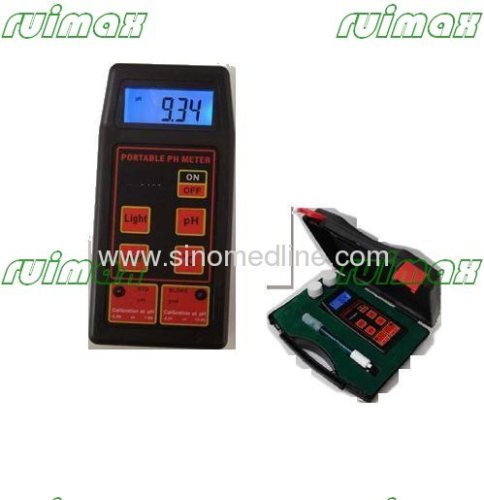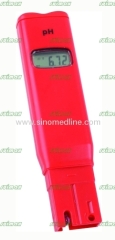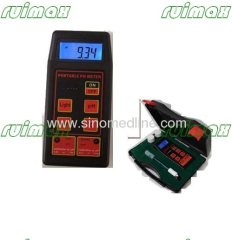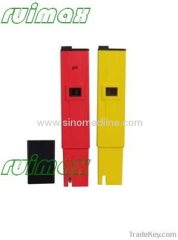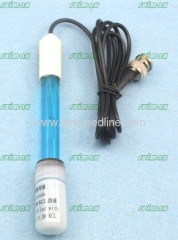
|
Ruimax Medical Instruments Co.,Ltd.
|
Digital PH Meter
| Payment Terms: | T/T |
| Place of Origin: | Zhejiang, China (Mainland) |
|
|
|
| Add to My Favorites | |
| HiSupplier Escrow |
Product Detail
High precision,complete-function,detection result display synchronously, operation simply.
Digital PH Meter
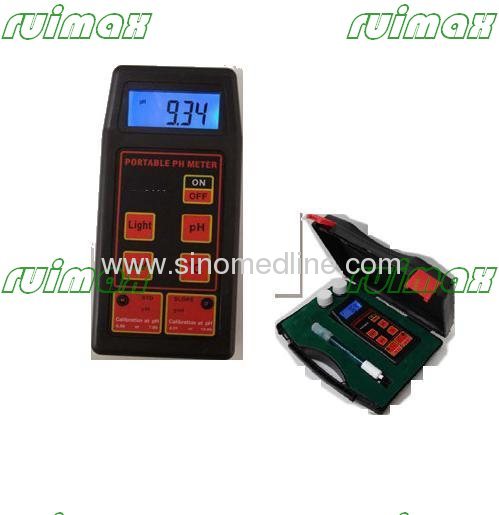
Feature:
High precision,complete-function,detection result display synchronously, operation simply.
Feature:
1. General Description
PH meter has been specially designed for the maximum facility of use. The handy key board for the selection of the various functions.
The possibility of automatically correcting errors in measurement due to temperature .The display on the front panel reveals the temperature and PH or mV reading taken by the instrument. Moreover, PH-8414 features a low battery
indicator .
2.Specifications
Range: PH 0.00~14.00PH
mV 1999~1999mV
Temperature 0~100℃
Resolution:
PH 0.01PH
PH 0.01PH
mV 1mV
Temperature 1℃
Accuracy: PH ±0.01PH
mV ±0.1% of the reading ±1 digit
Temperature ±0.4℃
Input Resistance: 10 12
Calibration: 1point or 2point
Power: 9V battery
Dimensions: 166×76×46mm
Operating Conditions : Temperature 5~60℃ Humidity 95%
Maximum
No disturbance of magnetic field or distinct tremble around
instrument.
Weight:210g
3.The front panel
Here is a brief description of the functions performed by each of the keys present on the keyboard.
ON/OFF: this is used for switching the instrument On and Off.
PH: this indicates the PH measurement revealed by the electrode.
mV: this indicates on the display panel the mV value revealed by the electrode.
℃:this indicates the temperature value revealed by the probe. This is the value used by the circuit for the PH measurement compensation.
LIGHT: lightens LCD the back light.
On the lower part of the front panel, tow trimmers are found for the regulation of the instrument. Their use will be described in chapter.
4.Interface and battery installation
This instrument has 2 functional interfaces and each of them is only to fit with its own plug.
1. PH electrode interface (or ORP) 2. temperature sensor interface Battery replace: the "---" symbol on the left of the LCD to indicate a low battery condition .Battery must be replace. Open the cap of battery on the back of the instrument and replace of the old battery with new battery. Attention to the anode and cathode of battery.
5.Operation
PH MEASUREMENTS: ·Turns on the PH electrode and the temperature sensor .
Turn the meter ON by pressing the ON/OFF key.
·Remove the PH electrode protective cap, then submerge the PH electrode and the temperature probe into the sample to be tested.
·Stir gently and wait for the stability symbol. The display will show the PH value automatically compensated for temperature.
·After use, rinse the electrode with clean water, replace the electrode protective cap.
ORP MEASUREMENTS: Oxidation Reduction Potential(ORP) measurements provide a quantification of the oxidizing or reducing power of the sample tested.
·Connect the ORP electrode to the BNC connector.
·To enter the "mV" mode turn the instrument ON and press the mV key until the display changes to mV.
·Then submerge the ORP electrode into the sample to be tested and allow time for the reading to stabilize.
TEMPERATURE MEASUREMENTS:
·Make sure the temperature probe is connected to the meter.
·Turn the instrument ON and press the ℃ key to select the temperature mode.
·Dip the temperature probe into the sample, allow the reading to stabilize and read the temperature value.
6.PH Calibration
·Pour a small quantity of PH6.86 and 4.01(or PH9.18)solution into clean beakers.
·For a particularly accurate calibration, it is advised to use two beakers for each buffer solution .the first is to be used for rinsing the electrode, the second is to be used for the calibration, in this way, the risks of contaminating the buffer solution are reduced to a minimum.
·Switch on the instrument. Press the PH key to display the PH measurement.
· Immerse the PH electrode and temperature probe into PH 6.86 buffer solution and then shake briefly.
·Regulate the trimmer found in the lower left hand position with a screwdriver until the buffer solution value corresponding to the measurement temperature is obtained.
·Immerse the electrode into a PH4.01 or PH9.18 buffer solution, and briefly shake the electrode.
·After about one minute, regulate the trimmer found in the lower right hand position until the buffer solution value corresponding to the measurement temperature is
obtained.
·The calibration of the instrument′s PH range is now complete.
Important:
The instrument′s PH range must be recalibrated whenever.
·The electrode has been replaced.
·Approximately one mouth has passed from the last calibration.
·The electrode has been used in particularly taxing conditions.
·The utmost accuracy is required.
7.Maintain electrode and instrument
1.Keep the electrode pin dry and clean.
2.Wash the electrode every time before you use. Then put it in 3mol/L KCL solution.
3.The electrode which is use to measure solution should not be dipped in distilled water , protein solution or other solution for long time.
8.Buffer Table
℃ PH4.00 PH6.86 PH9.18 ℃ PH4.00 PH6.86 PH9.18
0 4.01 6.98 9.46 45 4.04 6.83 9.04
0 4.01 6.98 9.46 45 4.04 6.83 9.04
5 4.00 6.95 9.39 50 4.06 6.83 9.02
10 4.00 6.92 9.33 55 4.07 6.83 8.99
15 4.00 6.90 9.28 60 4.09 6.84 8.97
20 4.00 6.88 9.23 65 4.11 6.84 8.95
25 4.00 6.86 9.18 70 4.12 6.85 8.93
30 4.01 6.85 9.14 80 4.16 6.86 8.89
35 4.02 6.84 9.10 90 4.20 6.88 8.86
40 4.03 6.84 9.07 95 4.22 6.89 8.84
9.Warranty
This instrument is guaranteed from all defects in material and production for a period of one year from the date of purchase. If during these periods the repair or the replacement of the instrument is required and the damage is not due to negligence or erroneous operation by the user, please return the instrument to either your dealer or to our offices and the repair will be effected free of charge.
Didn't find what you're looking for?
Post Buying Lead or contact
HiSupplier Customer Service Center
for help!
Related Search
PH Meter
Laboratory Ph Meter
Digital Meter
Lcd Digital Meter
Digital Power Meter
Digital Panel Meter
More>>

